E-commerce and Business Success: A Case Study of Argos UK
VerifiedAdded on 2024/06/27
|11
|2734
|294
AI Summary
This research project examines the impact of e-commerce on the business success of Argos UK, a leading retail organization in the United Kingdom. It explores the concept and evolution of e-commerce, analyzes its influence on Argos's business processes, and investigates the current trends and contributions of e-commerce to the company's overall success. The study utilizes a combination of literature review, surveys, and interviews to gather data and insights. The findings highlight the significant role of e-commerce in driving business growth, customer engagement, and operational efficiency for Argos UK.
Contribute Materials
Your contribution can guide someone’s learning journey. Share your
documents today.
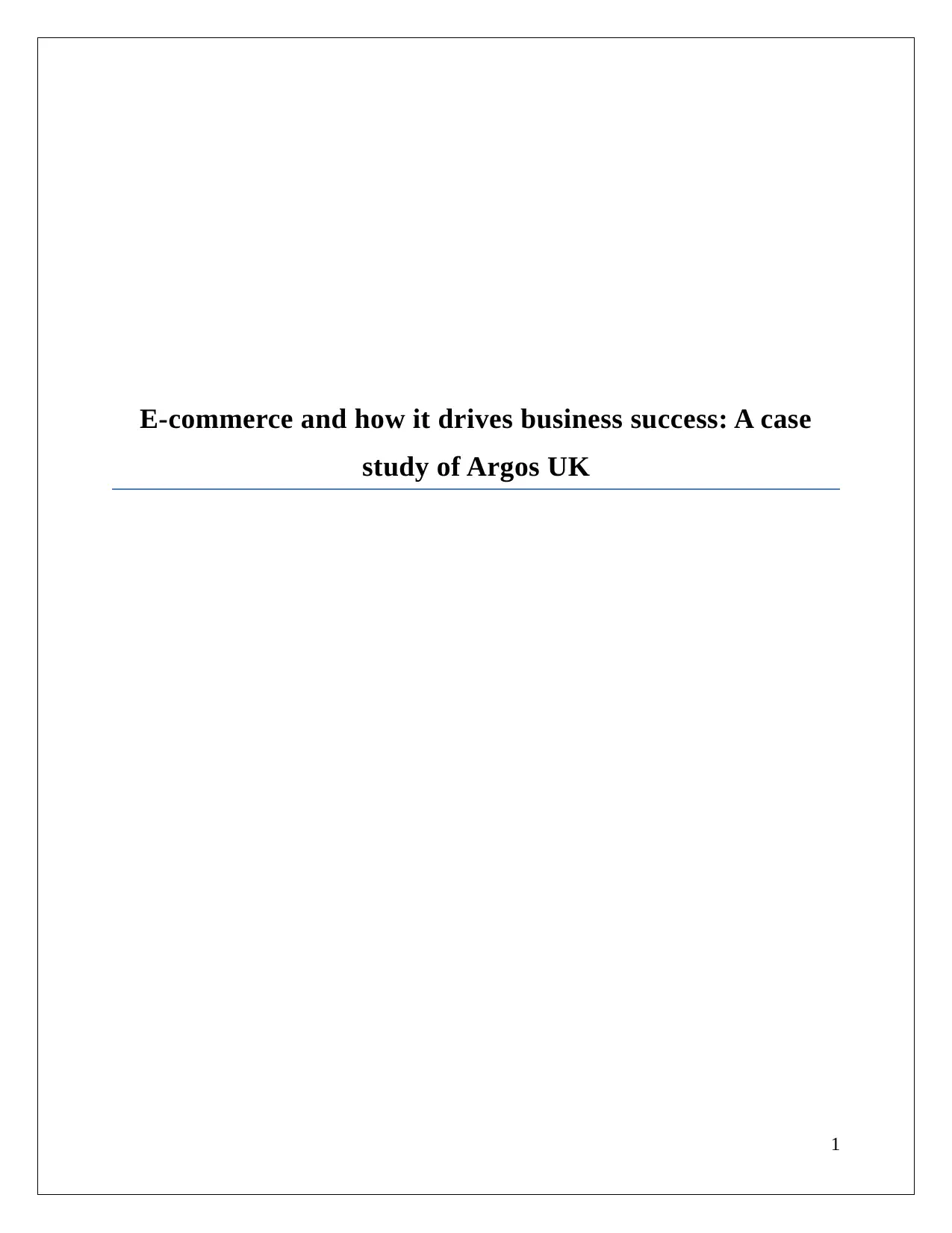
E-commerce and how it drives business success: A case
study of Argos UK
1
study of Argos UK
1
Secure Best Marks with AI Grader
Need help grading? Try our AI Grader for instant feedback on your assignments.

Introduction:
Title of the research project: E-commerce and how it drives business success
Background of the research:
With the technological advancement, the principle idea of trade and business process has
changed drastically. Unlike the traditional mediums of business, the idea of electronic commerce
allows the concerned companies to conduct business over the digital platform. E-commerce is
defined as the process of trade where products and services are purchased over online platforms.
In order to determine the electronic commerce, there is a wide spectrum of parameters which
needs to be considered. E-commerce is dependent on many technological parameters like
electronic fund transfer, marketing via online platforms, online transaction process, data
collection and data exchange and supply chain management. The World Wide Web is the most
significant part of electronic commerce because the overall process is conducted on the web
platform (Scarborough 2016).
In this research project, the business process of Argos UK has been considered. Argos is an retail
organization headquartered in Milton Keynes, United Kingdom. The company was first
introduced in the year 1972 and is one of the largest retail organizations in the United Kingdom
(www.argos.co.uk 2018).
Aims and objectives:
To determine the concept and idea of electronic commerce
To analyze the impact of electronic commerce on the overall business process of Argos
UK
To determine the present trend and how electronic commerce contributes in the overall
business process of Argos UK
Research questions:
The concept and idea of electronic commerce?
The impact of electronic commerce on the business process of Argos UK?
The current trend and the contribution of electronic commerce on the business of Argos
UK?
Rationale of the study:
2
Title of the research project: E-commerce and how it drives business success
Background of the research:
With the technological advancement, the principle idea of trade and business process has
changed drastically. Unlike the traditional mediums of business, the idea of electronic commerce
allows the concerned companies to conduct business over the digital platform. E-commerce is
defined as the process of trade where products and services are purchased over online platforms.
In order to determine the electronic commerce, there is a wide spectrum of parameters which
needs to be considered. E-commerce is dependent on many technological parameters like
electronic fund transfer, marketing via online platforms, online transaction process, data
collection and data exchange and supply chain management. The World Wide Web is the most
significant part of electronic commerce because the overall process is conducted on the web
platform (Scarborough 2016).
In this research project, the business process of Argos UK has been considered. Argos is an retail
organization headquartered in Milton Keynes, United Kingdom. The company was first
introduced in the year 1972 and is one of the largest retail organizations in the United Kingdom
(www.argos.co.uk 2018).
Aims and objectives:
To determine the concept and idea of electronic commerce
To analyze the impact of electronic commerce on the overall business process of Argos
UK
To determine the present trend and how electronic commerce contributes in the overall
business process of Argos UK
Research questions:
The concept and idea of electronic commerce?
The impact of electronic commerce on the business process of Argos UK?
The current trend and the contribution of electronic commerce on the business of Argos
UK?
Rationale of the study:
2
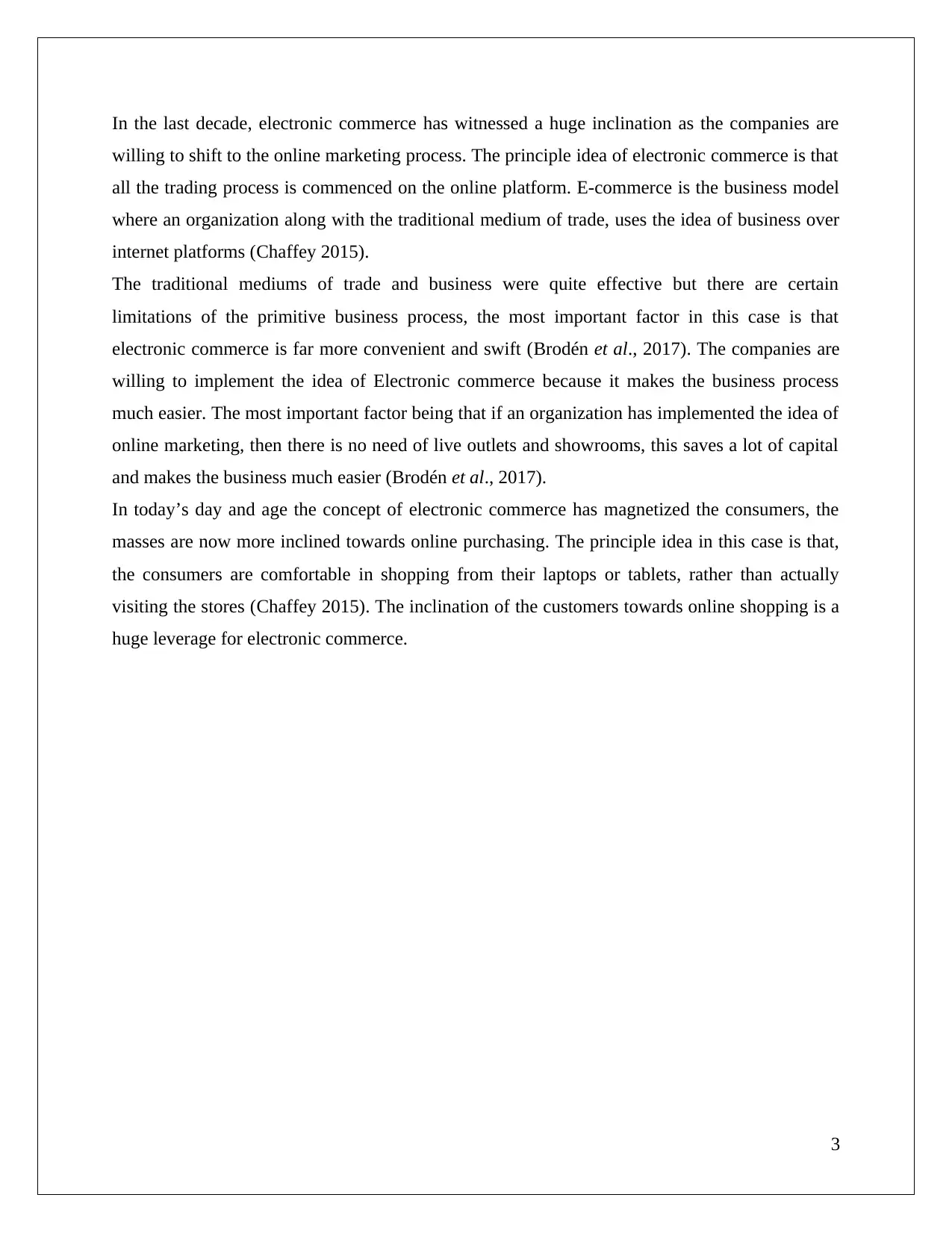
In the last decade, electronic commerce has witnessed a huge inclination as the companies are
willing to shift to the online marketing process. The principle idea of electronic commerce is that
all the trading process is commenced on the online platform. E-commerce is the business model
where an organization along with the traditional medium of trade, uses the idea of business over
internet platforms (Chaffey 2015).
The traditional mediums of trade and business were quite effective but there are certain
limitations of the primitive business process, the most important factor in this case is that
electronic commerce is far more convenient and swift (Brodén et al., 2017). The companies are
willing to implement the idea of Electronic commerce because it makes the business process
much easier. The most important factor being that if an organization has implemented the idea of
online marketing, then there is no need of live outlets and showrooms, this saves a lot of capital
and makes the business much easier (Brodén et al., 2017).
In today’s day and age the concept of electronic commerce has magnetized the consumers, the
masses are now more inclined towards online purchasing. The principle idea in this case is that,
the consumers are comfortable in shopping from their laptops or tablets, rather than actually
visiting the stores (Chaffey 2015). The inclination of the customers towards online shopping is a
huge leverage for electronic commerce.
3
willing to shift to the online marketing process. The principle idea of electronic commerce is that
all the trading process is commenced on the online platform. E-commerce is the business model
where an organization along with the traditional medium of trade, uses the idea of business over
internet platforms (Chaffey 2015).
The traditional mediums of trade and business were quite effective but there are certain
limitations of the primitive business process, the most important factor in this case is that
electronic commerce is far more convenient and swift (Brodén et al., 2017). The companies are
willing to implement the idea of Electronic commerce because it makes the business process
much easier. The most important factor being that if an organization has implemented the idea of
online marketing, then there is no need of live outlets and showrooms, this saves a lot of capital
and makes the business much easier (Brodén et al., 2017).
In today’s day and age the concept of electronic commerce has magnetized the consumers, the
masses are now more inclined towards online purchasing. The principle idea in this case is that,
the consumers are comfortable in shopping from their laptops or tablets, rather than actually
visiting the stores (Chaffey 2015). The inclination of the customers towards online shopping is a
huge leverage for electronic commerce.
3
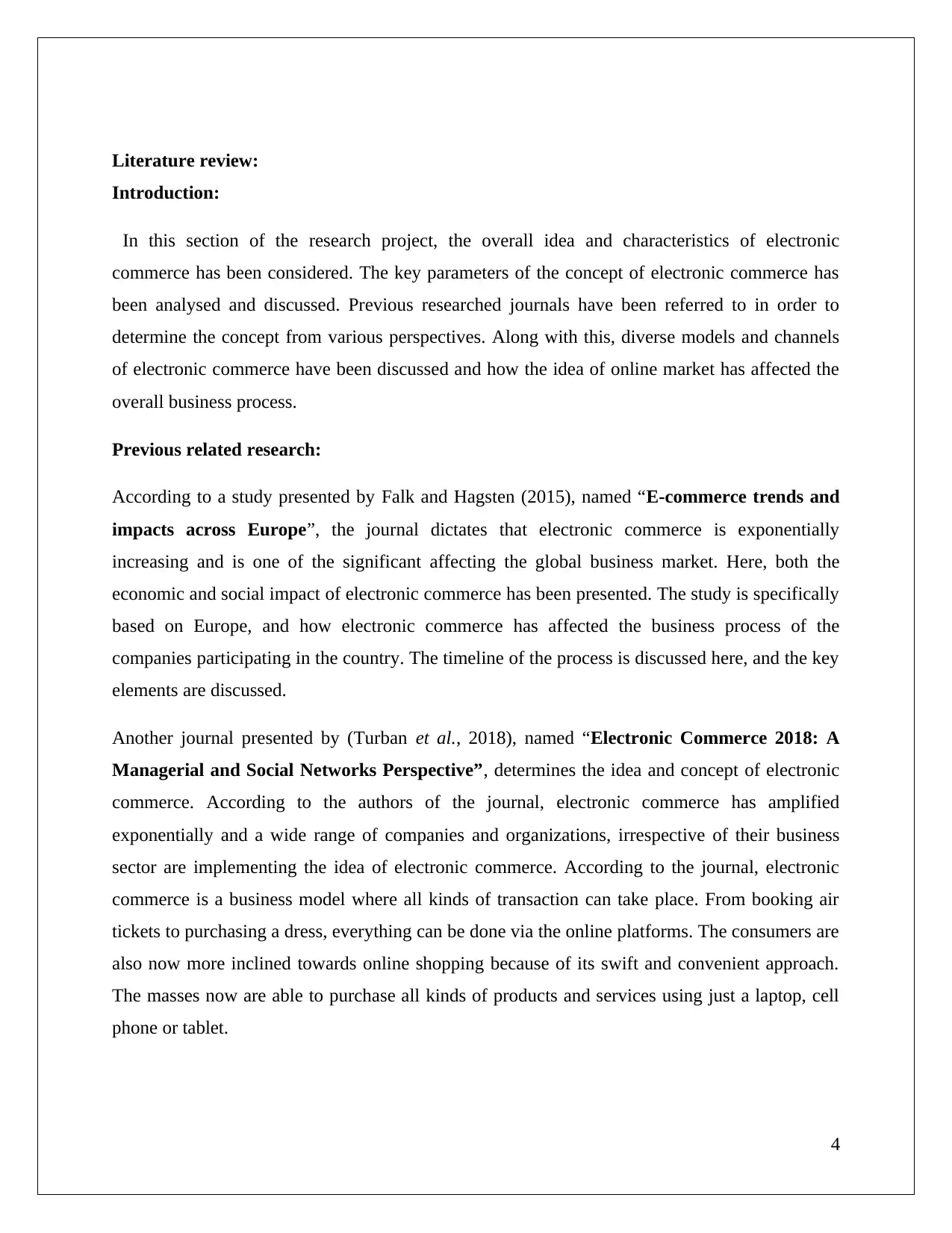
Literature review:
Introduction:
In this section of the research project, the overall idea and characteristics of electronic
commerce has been considered. The key parameters of the concept of electronic commerce has
been analysed and discussed. Previous researched journals have been referred to in order to
determine the concept from various perspectives. Along with this, diverse models and channels
of electronic commerce have been discussed and how the idea of online market has affected the
overall business process.
Previous related research:
According to a study presented by Falk and Hagsten (2015), named “E-commerce trends and
impacts across Europe”, the journal dictates that electronic commerce is exponentially
increasing and is one of the significant affecting the global business market. Here, both the
economic and social impact of electronic commerce has been presented. The study is specifically
based on Europe, and how electronic commerce has affected the business process of the
companies participating in the country. The timeline of the process is discussed here, and the key
elements are discussed.
Another journal presented by (Turban et al., 2018), named “Electronic Commerce 2018: A
Managerial and Social Networks Perspective”, determines the idea and concept of electronic
commerce. According to the authors of the journal, electronic commerce has amplified
exponentially and a wide range of companies and organizations, irrespective of their business
sector are implementing the idea of electronic commerce. According to the journal, electronic
commerce is a business model where all kinds of transaction can take place. From booking air
tickets to purchasing a dress, everything can be done via the online platforms. The consumers are
also now more inclined towards online shopping because of its swift and convenient approach.
The masses now are able to purchase all kinds of products and services using just a laptop, cell
phone or tablet.
4
Introduction:
In this section of the research project, the overall idea and characteristics of electronic
commerce has been considered. The key parameters of the concept of electronic commerce has
been analysed and discussed. Previous researched journals have been referred to in order to
determine the concept from various perspectives. Along with this, diverse models and channels
of electronic commerce have been discussed and how the idea of online market has affected the
overall business process.
Previous related research:
According to a study presented by Falk and Hagsten (2015), named “E-commerce trends and
impacts across Europe”, the journal dictates that electronic commerce is exponentially
increasing and is one of the significant affecting the global business market. Here, both the
economic and social impact of electronic commerce has been presented. The study is specifically
based on Europe, and how electronic commerce has affected the business process of the
companies participating in the country. The timeline of the process is discussed here, and the key
elements are discussed.
Another journal presented by (Turban et al., 2018), named “Electronic Commerce 2018: A
Managerial and Social Networks Perspective”, determines the idea and concept of electronic
commerce. According to the authors of the journal, electronic commerce has amplified
exponentially and a wide range of companies and organizations, irrespective of their business
sector are implementing the idea of electronic commerce. According to the journal, electronic
commerce is a business model where all kinds of transaction can take place. From booking air
tickets to purchasing a dress, everything can be done via the online platforms. The consumers are
also now more inclined towards online shopping because of its swift and convenient approach.
The masses now are able to purchase all kinds of products and services using just a laptop, cell
phone or tablet.
4
Paraphrase This Document
Need a fresh take? Get an instant paraphrase of this document with our AI Paraphraser
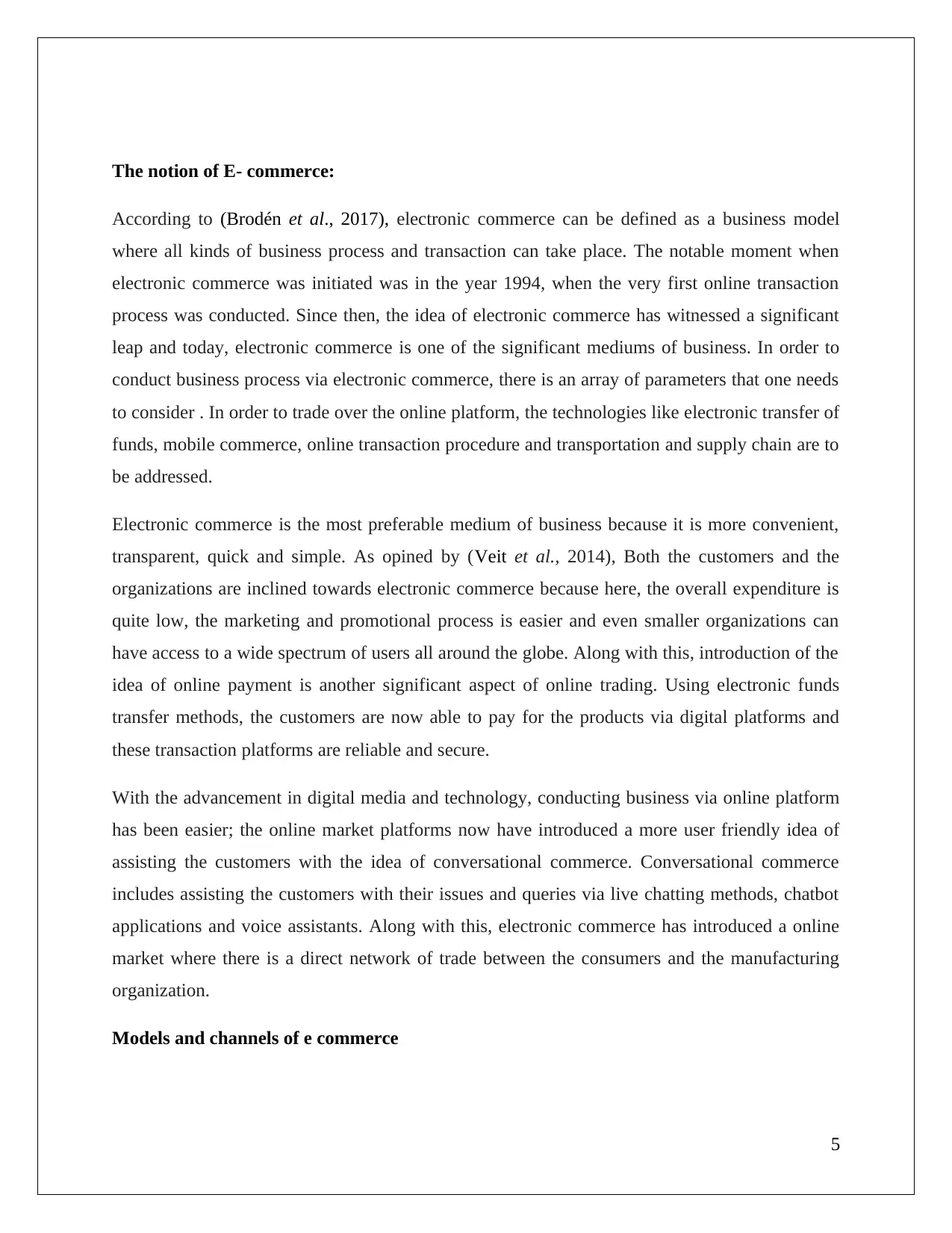
The notion of E- commerce:
According to (Brodén et al., 2017), electronic commerce can be defined as a business model
where all kinds of business process and transaction can take place. The notable moment when
electronic commerce was initiated was in the year 1994, when the very first online transaction
process was conducted. Since then, the idea of electronic commerce has witnessed a significant
leap and today, electronic commerce is one of the significant mediums of business. In order to
conduct business process via electronic commerce, there is an array of parameters that one needs
to consider . In order to trade over the online platform, the technologies like electronic transfer of
funds, mobile commerce, online transaction procedure and transportation and supply chain are to
be addressed.
Electronic commerce is the most preferable medium of business because it is more convenient,
transparent, quick and simple. As opined by (Veit et al., 2014), Both the customers and the
organizations are inclined towards electronic commerce because here, the overall expenditure is
quite low, the marketing and promotional process is easier and even smaller organizations can
have access to a wide spectrum of users all around the globe. Along with this, introduction of the
idea of online payment is another significant aspect of online trading. Using electronic funds
transfer methods, the customers are now able to pay for the products via digital platforms and
these transaction platforms are reliable and secure.
With the advancement in digital media and technology, conducting business via online platform
has been easier; the online market platforms now have introduced a more user friendly idea of
assisting the customers with the idea of conversational commerce. Conversational commerce
includes assisting the customers with their issues and queries via live chatting methods, chatbot
applications and voice assistants. Along with this, electronic commerce has introduced a online
market where there is a direct network of trade between the consumers and the manufacturing
organization.
Models and channels of e commerce
5
According to (Brodén et al., 2017), electronic commerce can be defined as a business model
where all kinds of business process and transaction can take place. The notable moment when
electronic commerce was initiated was in the year 1994, when the very first online transaction
process was conducted. Since then, the idea of electronic commerce has witnessed a significant
leap and today, electronic commerce is one of the significant mediums of business. In order to
conduct business process via electronic commerce, there is an array of parameters that one needs
to consider . In order to trade over the online platform, the technologies like electronic transfer of
funds, mobile commerce, online transaction procedure and transportation and supply chain are to
be addressed.
Electronic commerce is the most preferable medium of business because it is more convenient,
transparent, quick and simple. As opined by (Veit et al., 2014), Both the customers and the
organizations are inclined towards electronic commerce because here, the overall expenditure is
quite low, the marketing and promotional process is easier and even smaller organizations can
have access to a wide spectrum of users all around the globe. Along with this, introduction of the
idea of online payment is another significant aspect of online trading. Using electronic funds
transfer methods, the customers are now able to pay for the products via digital platforms and
these transaction platforms are reliable and secure.
With the advancement in digital media and technology, conducting business via online platform
has been easier; the online market platforms now have introduced a more user friendly idea of
assisting the customers with the idea of conversational commerce. Conversational commerce
includes assisting the customers with their issues and queries via live chatting methods, chatbot
applications and voice assistants. Along with this, electronic commerce has introduced a online
market where there is a direct network of trade between the consumers and the manufacturing
organization.
Models and channels of e commerce
5

Electronic commerce can be classified into four segments, the first one is the B2B, the Business
to Business type, the second one is the B2C, Business to Consumer type, the third type is the
C2C, the Consumer to Consumer type and the last one is the C2B, the Consumer to Business
type. According to (Radovilsky 2015), there are multiple models of electronic commerce that can
be referred to in order to depending on the type of e-Commerce model. There are many models
of electronic commerce. The present active models are Drop shipping, wholesaling and
Warehousing, White-labeling, manufacturing and Subscription-based model. The Wholesaling
and warehousing model and the Drop shipping model is the most commonly used model of
electronic commerce. In a wholesaling and warehousing ecommerce model, the online market
stores older products and materials directly from the suppliers and dealers. After the suppliers
send the products to the online stores, warehouses are used in order to preserve the products, and
after the consumer place the order, the products are shipped directly from the warehouse. Here
the initial investment is quite huge but because the pricing is done on a wholesale rate thus
having a huge profit margin. According to (Radovilsky 2015), The Drop shipping model of
electronic commerce is where the online market acts as a medium. Here, the consumers place
their order and the online stores receive the order and pas it down to the supplier and the supplier
sends the product directly to the customers.
Impact of E commerce on the business process:
Electronic commerce being a significant part of the global business market today has
considerable impact on the overall business process. According to (Lian and Yen 2014), the most
important aspect here is that electronic commerce far supersedes the idea of traditional business
process.
The consumers now are more inclined towards E-commerce because it is more convenient,
transparent and easy.
Along with this, the idea of E-commerce also affects the economy of the business scenario. The
organisations adopting the idea of electronic commerce have witnessed lower expenditure
because there is no need of outlets and showrooms. Along with this, the small scale
6
to Business type, the second one is the B2C, Business to Consumer type, the third type is the
C2C, the Consumer to Consumer type and the last one is the C2B, the Consumer to Business
type. According to (Radovilsky 2015), there are multiple models of electronic commerce that can
be referred to in order to depending on the type of e-Commerce model. There are many models
of electronic commerce. The present active models are Drop shipping, wholesaling and
Warehousing, White-labeling, manufacturing and Subscription-based model. The Wholesaling
and warehousing model and the Drop shipping model is the most commonly used model of
electronic commerce. In a wholesaling and warehousing ecommerce model, the online market
stores older products and materials directly from the suppliers and dealers. After the suppliers
send the products to the online stores, warehouses are used in order to preserve the products, and
after the consumer place the order, the products are shipped directly from the warehouse. Here
the initial investment is quite huge but because the pricing is done on a wholesale rate thus
having a huge profit margin. According to (Radovilsky 2015), The Drop shipping model of
electronic commerce is where the online market acts as a medium. Here, the consumers place
their order and the online stores receive the order and pas it down to the supplier and the supplier
sends the product directly to the customers.
Impact of E commerce on the business process:
Electronic commerce being a significant part of the global business market today has
considerable impact on the overall business process. According to (Lian and Yen 2014), the most
important aspect here is that electronic commerce far supersedes the idea of traditional business
process.
The consumers now are more inclined towards E-commerce because it is more convenient,
transparent and easy.
Along with this, the idea of E-commerce also affects the economy of the business scenario. The
organisations adopting the idea of electronic commerce have witnessed lower expenditure
because there is no need of outlets and showrooms. Along with this, the small scale
6
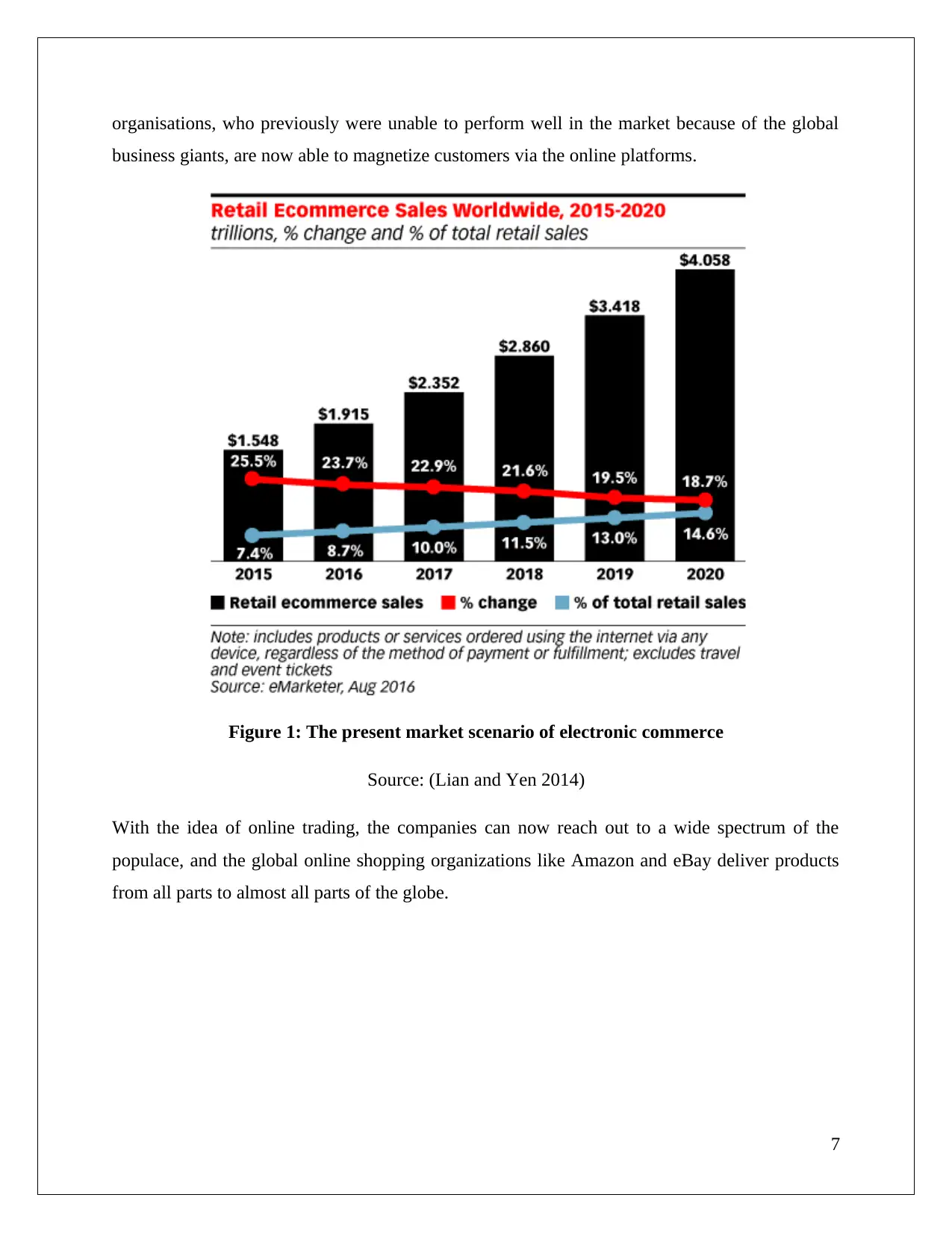
organisations, who previously were unable to perform well in the market because of the global
business giants, are now able to magnetize customers via the online platforms.
Figure 1: The present market scenario of electronic commerce
Source: (Lian and Yen 2014)
With the idea of online trading, the companies can now reach out to a wide spectrum of the
populace, and the global online shopping organizations like Amazon and eBay deliver products
from all parts to almost all parts of the globe.
7
business giants, are now able to magnetize customers via the online platforms.
Figure 1: The present market scenario of electronic commerce
Source: (Lian and Yen 2014)
With the idea of online trading, the companies can now reach out to a wide spectrum of the
populace, and the global online shopping organizations like Amazon and eBay deliver products
from all parts to almost all parts of the globe.
7
Secure Best Marks with AI Grader
Need help grading? Try our AI Grader for instant feedback on your assignments.
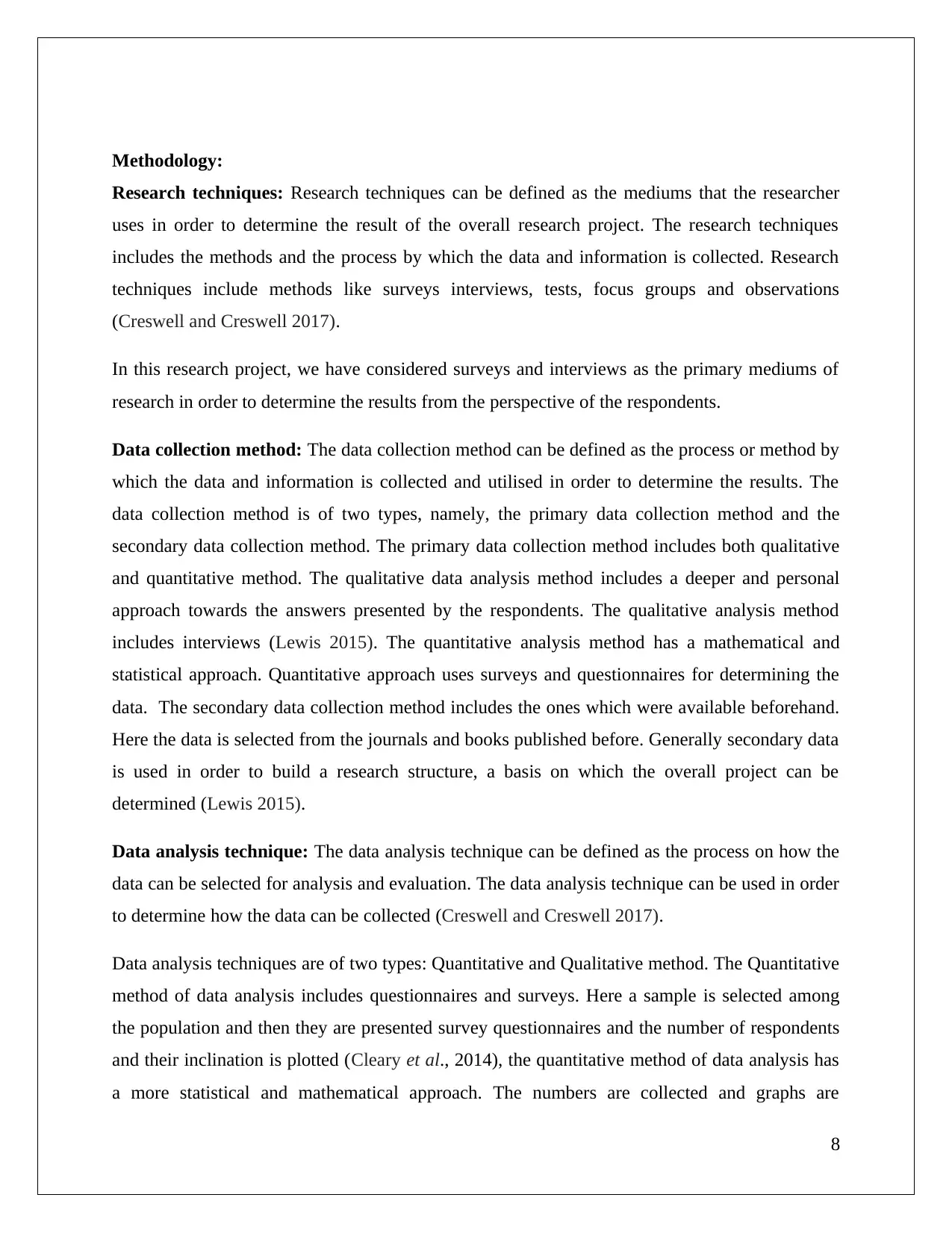
Methodology:
Research techniques: Research techniques can be defined as the mediums that the researcher
uses in order to determine the result of the overall research project. The research techniques
includes the methods and the process by which the data and information is collected. Research
techniques include methods like surveys interviews, tests, focus groups and observations
(Creswell and Creswell 2017).
In this research project, we have considered surveys and interviews as the primary mediums of
research in order to determine the results from the perspective of the respondents.
Data collection method: The data collection method can be defined as the process or method by
which the data and information is collected and utilised in order to determine the results. The
data collection method is of two types, namely, the primary data collection method and the
secondary data collection method. The primary data collection method includes both qualitative
and quantitative method. The qualitative data analysis method includes a deeper and personal
approach towards the answers presented by the respondents. The qualitative analysis method
includes interviews (Lewis 2015). The quantitative analysis method has a mathematical and
statistical approach. Quantitative approach uses surveys and questionnaires for determining the
data. The secondary data collection method includes the ones which were available beforehand.
Here the data is selected from the journals and books published before. Generally secondary data
is used in order to build a research structure, a basis on which the overall project can be
determined (Lewis 2015).
Data analysis technique: The data analysis technique can be defined as the process on how the
data can be selected for analysis and evaluation. The data analysis technique can be used in order
to determine how the data can be collected (Creswell and Creswell 2017).
Data analysis techniques are of two types: Quantitative and Qualitative method. The Quantitative
method of data analysis includes questionnaires and surveys. Here a sample is selected among
the population and then they are presented survey questionnaires and the number of respondents
and their inclination is plotted (Cleary et al., 2014), the quantitative method of data analysis has
a more statistical and mathematical approach. The numbers are collected and graphs are
8
Research techniques: Research techniques can be defined as the mediums that the researcher
uses in order to determine the result of the overall research project. The research techniques
includes the methods and the process by which the data and information is collected. Research
techniques include methods like surveys interviews, tests, focus groups and observations
(Creswell and Creswell 2017).
In this research project, we have considered surveys and interviews as the primary mediums of
research in order to determine the results from the perspective of the respondents.
Data collection method: The data collection method can be defined as the process or method by
which the data and information is collected and utilised in order to determine the results. The
data collection method is of two types, namely, the primary data collection method and the
secondary data collection method. The primary data collection method includes both qualitative
and quantitative method. The qualitative data analysis method includes a deeper and personal
approach towards the answers presented by the respondents. The qualitative analysis method
includes interviews (Lewis 2015). The quantitative analysis method has a mathematical and
statistical approach. Quantitative approach uses surveys and questionnaires for determining the
data. The secondary data collection method includes the ones which were available beforehand.
Here the data is selected from the journals and books published before. Generally secondary data
is used in order to build a research structure, a basis on which the overall project can be
determined (Lewis 2015).
Data analysis technique: The data analysis technique can be defined as the process on how the
data can be selected for analysis and evaluation. The data analysis technique can be used in order
to determine how the data can be collected (Creswell and Creswell 2017).
Data analysis techniques are of two types: Quantitative and Qualitative method. The Quantitative
method of data analysis includes questionnaires and surveys. Here a sample is selected among
the population and then they are presented survey questionnaires and the number of respondents
and their inclination is plotted (Cleary et al., 2014), the quantitative method of data analysis has
a more statistical and mathematical approach. The numbers are collected and graphs are
8
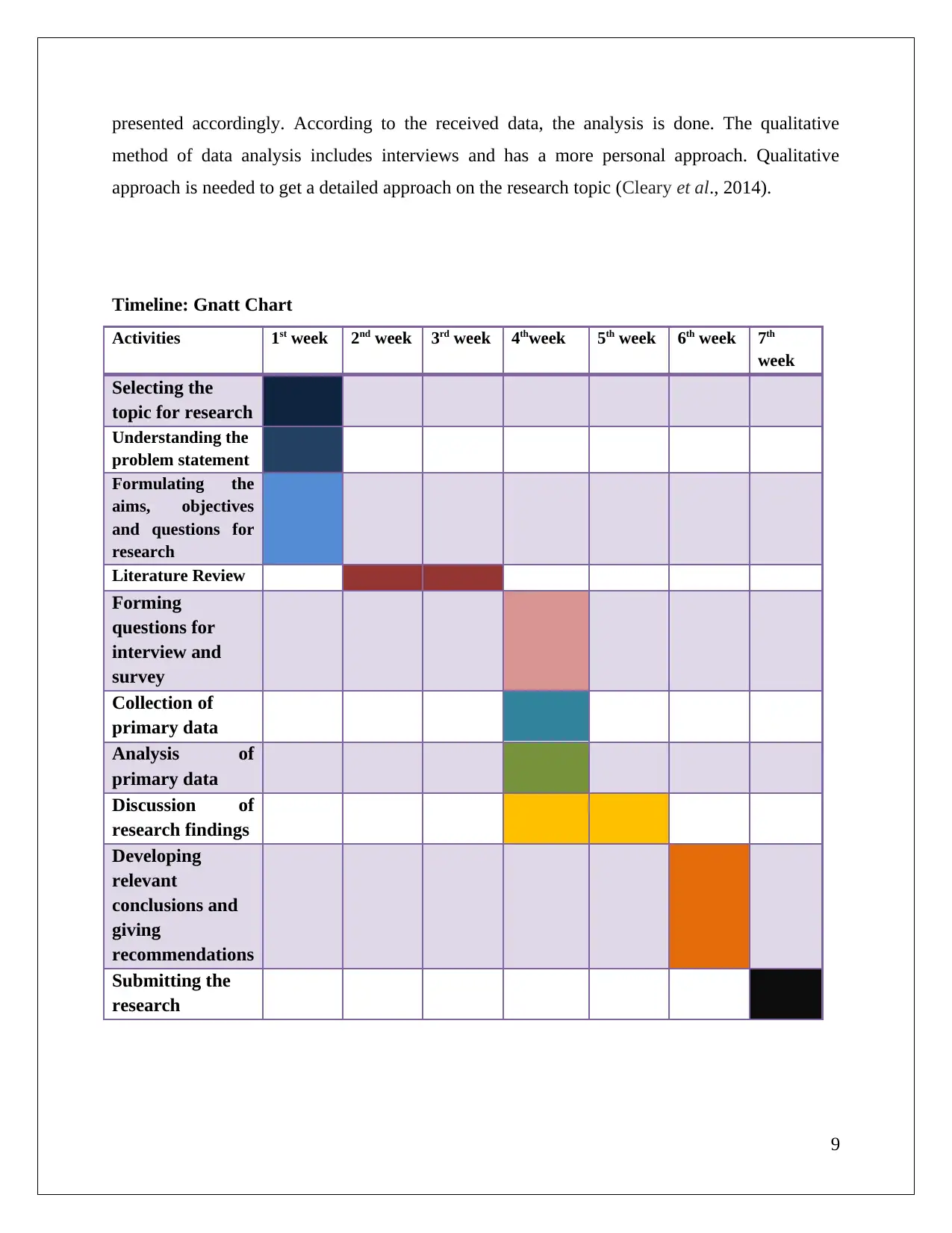
presented accordingly. According to the received data, the analysis is done. The qualitative
method of data analysis includes interviews and has a more personal approach. Qualitative
approach is needed to get a detailed approach on the research topic (Cleary et al., 2014).
Timeline: Gnatt Chart
Activities 1st week 2nd week 3rd week 4thweek 5th week 6th week 7th
week
Selecting the
topic for research
Understanding the
problem statement
Formulating the
aims, objectives
and questions for
research
Literature Review
Forming
questions for
interview and
survey
Collection of
primary data
Analysis of
primary data
Discussion of
research findings
Developing
relevant
conclusions and
giving
recommendations
Submitting the
research
9
method of data analysis includes interviews and has a more personal approach. Qualitative
approach is needed to get a detailed approach on the research topic (Cleary et al., 2014).
Timeline: Gnatt Chart
Activities 1st week 2nd week 3rd week 4thweek 5th week 6th week 7th
week
Selecting the
topic for research
Understanding the
problem statement
Formulating the
aims, objectives
and questions for
research
Literature Review
Forming
questions for
interview and
survey
Collection of
primary data
Analysis of
primary data
Discussion of
research findings
Developing
relevant
conclusions and
giving
recommendations
Submitting the
research
9
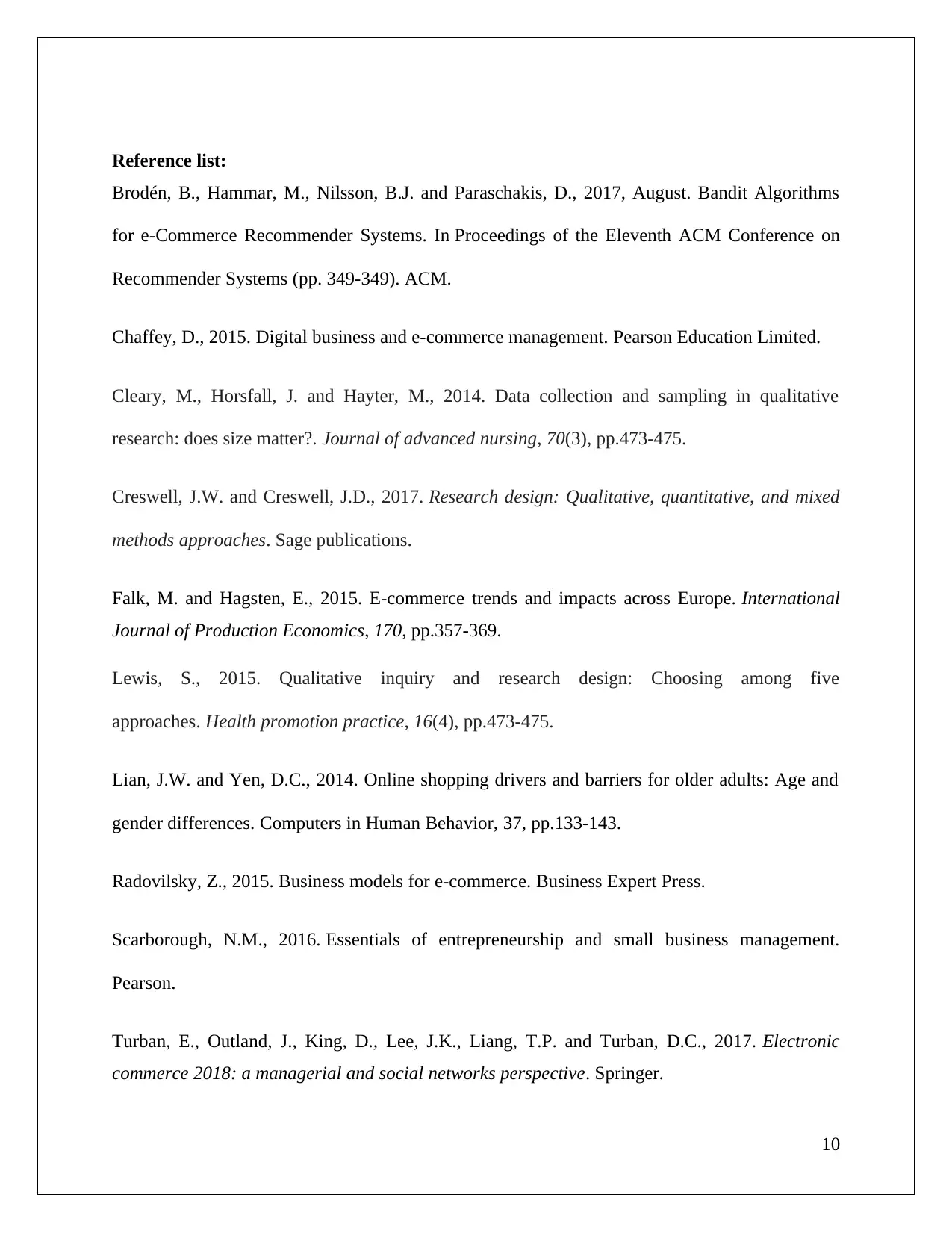
Reference list:
Brodén, B., Hammar, M., Nilsson, B.J. and Paraschakis, D., 2017, August. Bandit Algorithms
for e-Commerce Recommender Systems. In Proceedings of the Eleventh ACM Conference on
Recommender Systems (pp. 349-349). ACM.
Chaffey, D., 2015. Digital business and e-commerce management. Pearson Education Limited.
Cleary, M., Horsfall, J. and Hayter, M., 2014. Data collection and sampling in qualitative
research: does size matter?. Journal of advanced nursing, 70(3), pp.473-475.
Creswell, J.W. and Creswell, J.D., 2017. Research design: Qualitative, quantitative, and mixed
methods approaches. Sage publications.
Falk, M. and Hagsten, E., 2015. E-commerce trends and impacts across Europe. International
Journal of Production Economics, 170, pp.357-369.
Lewis, S., 2015. Qualitative inquiry and research design: Choosing among five
approaches. Health promotion practice, 16(4), pp.473-475.
Lian, J.W. and Yen, D.C., 2014. Online shopping drivers and barriers for older adults: Age and
gender differences. Computers in Human Behavior, 37, pp.133-143.
Radovilsky, Z., 2015. Business models for e-commerce. Business Expert Press.
Scarborough, N.M., 2016. Essentials of entrepreneurship and small business management.
Pearson.
Turban, E., Outland, J., King, D., Lee, J.K., Liang, T.P. and Turban, D.C., 2017. Electronic
commerce 2018: a managerial and social networks perspective. Springer.
10
Brodén, B., Hammar, M., Nilsson, B.J. and Paraschakis, D., 2017, August. Bandit Algorithms
for e-Commerce Recommender Systems. In Proceedings of the Eleventh ACM Conference on
Recommender Systems (pp. 349-349). ACM.
Chaffey, D., 2015. Digital business and e-commerce management. Pearson Education Limited.
Cleary, M., Horsfall, J. and Hayter, M., 2014. Data collection and sampling in qualitative
research: does size matter?. Journal of advanced nursing, 70(3), pp.473-475.
Creswell, J.W. and Creswell, J.D., 2017. Research design: Qualitative, quantitative, and mixed
methods approaches. Sage publications.
Falk, M. and Hagsten, E., 2015. E-commerce trends and impacts across Europe. International
Journal of Production Economics, 170, pp.357-369.
Lewis, S., 2015. Qualitative inquiry and research design: Choosing among five
approaches. Health promotion practice, 16(4), pp.473-475.
Lian, J.W. and Yen, D.C., 2014. Online shopping drivers and barriers for older adults: Age and
gender differences. Computers in Human Behavior, 37, pp.133-143.
Radovilsky, Z., 2015. Business models for e-commerce. Business Expert Press.
Scarborough, N.M., 2016. Essentials of entrepreneurship and small business management.
Pearson.
Turban, E., Outland, J., King, D., Lee, J.K., Liang, T.P. and Turban, D.C., 2017. Electronic
commerce 2018: a managerial and social networks perspective. Springer.
10
Paraphrase This Document
Need a fresh take? Get an instant paraphrase of this document with our AI Paraphraser
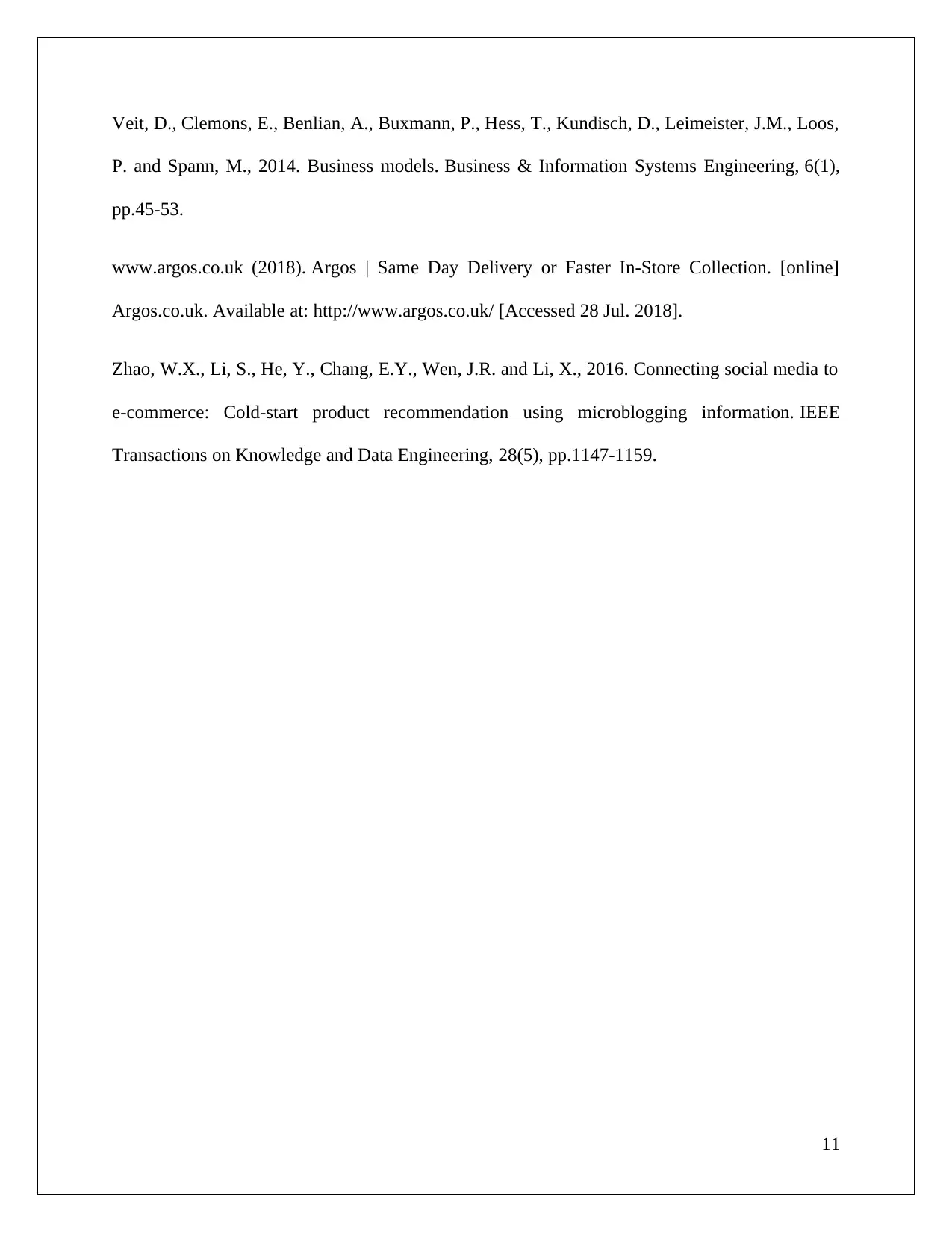
Veit, D., Clemons, E., Benlian, A., Buxmann, P., Hess, T., Kundisch, D., Leimeister, J.M., Loos,
P. and Spann, M., 2014. Business models. Business & Information Systems Engineering, 6(1),
pp.45-53.
www.argos.co.uk (2018). Argos | Same Day Delivery or Faster In-Store Collection. [online]
Argos.co.uk. Available at: http://www.argos.co.uk/ [Accessed 28 Jul. 2018].
Zhao, W.X., Li, S., He, Y., Chang, E.Y., Wen, J.R. and Li, X., 2016. Connecting social media to
e-commerce: Cold-start product recommendation using microblogging information. IEEE
Transactions on Knowledge and Data Engineering, 28(5), pp.1147-1159.
11
P. and Spann, M., 2014. Business models. Business & Information Systems Engineering, 6(1),
pp.45-53.
www.argos.co.uk (2018). Argos | Same Day Delivery or Faster In-Store Collection. [online]
Argos.co.uk. Available at: http://www.argos.co.uk/ [Accessed 28 Jul. 2018].
Zhao, W.X., Li, S., He, Y., Chang, E.Y., Wen, J.R. and Li, X., 2016. Connecting social media to
e-commerce: Cold-start product recommendation using microblogging information. IEEE
Transactions on Knowledge and Data Engineering, 28(5), pp.1147-1159.
11
1 out of 11
Related Documents
Your All-in-One AI-Powered Toolkit for Academic Success.
+13062052269
info@desklib.com
Available 24*7 on WhatsApp / Email
![[object Object]](/_next/static/media/star-bottom.7253800d.svg)
Unlock your academic potential
© 2024 | Zucol Services PVT LTD | All rights reserved.




